What do soldiers of different countries eat in battle? The history of army suhpaykov
For soldiers, travelers, astronauts and civilians in the absence of the ability to cook hot food, they develop dry rations - individual rations. As a rule, such sets are designed for a day or for one meal. In the military, they differ, including depending on the type of troops.
Professionals responsible for the development of IRP, you need to calculate not only the caloric content of the set, but many other parameters. All products should be easily digested, not cause allergies, be stored for a long time. Products must be prepared or easy to prepare.
It is necessary to consider the conditions in which a person will use the kit. Individual diets for pilots of the Solar Impulse team, who recently completed a round-the-world trip on a "solar" plane , were developed by eight scientists from Nestle .

The history of technology for long-term storage of products
Salting and pickling
One of the oldest preservatives is salt. It was used to preserve meat and fish products. Salt draws moisture out of the product, the product is impregnated with a solution of salt and bacteria cannot develop in it.
In this way, sailors actively used before people started canning meat in jars. The basis of the sailor's diet was corned beef and crackers. Although such a diet could be sufficient for the energy value by today's standards, it lacked vitamins. Hence scurvy and other occupational diseases.
Porridge combines acid preservation and pickling. Sauerkraut could also be included in the "marine" diet.
Dehydration
One of the oldest and simplest methods of long-term storage of food is dehydration or drying. This is how fruits, fish, meat and vegetables are stored. With a decrease in moisture content in food products below 15%, microorganisms do not start in them.
You can dry in the open air, in the wind to prevent rotting, using a vacuum.
During the Crimean campaign, dried vegetables were used in the Russian army. On the day the soldier was given 250 grams of fresh or 20 grams of dried vegetables, which were added to soups.
To preserve the suitability of its bread baked twice or simply dried. Dried rusks were not stored as well as baked. Rusks were used by soldiers. sailors and expeditions. Now, instead of them in the suhpayki go biscuits. Simple biscuits retain nutritional quality up to two years.
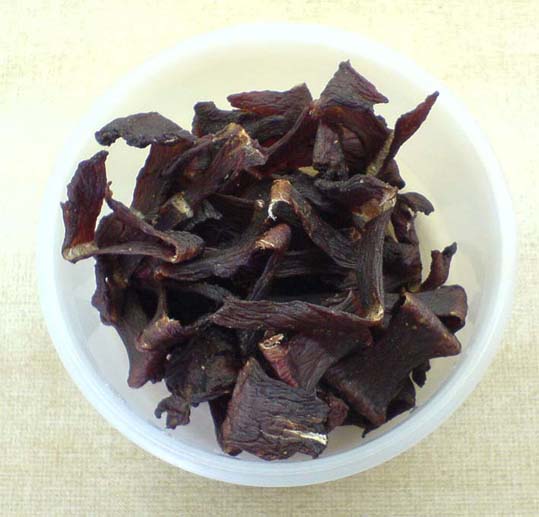
Dried beef. A source
Preservation
Anthony van Leeuwenhoek in the 17th century invented a microscope capable of magnifying 275 times. Scientists opened the world of microbes, the smallest creatures that live wherever possible, and are able to move with the air flow. And immediately disputes arose: how do these microbes appear? How are they born? Do they come from rotting hay or food, or are there any eggs from which they hatch?
The abbot naturalist Latstsaro Spallanzani decided in the 18th century to prove that microbes have parents: “Are microbes infused in all sorts of infusions? Do they infuse themselves into lamb gravy? comin there their parents. " He boiled and heated lamb gravy, but microbes appeared. He plugged his neck with a cork, but that didn't help either. But one day he sealed the bottle. Gravy in bottles with a sealed neck, subjected to prolonged boiling, remained transparent for a long time. So he tried to prove that microbes get into products from the air.
Not everyone agreed with Spallanzani. The English priest and naturalist J. Needham and Count Buffon united against him with the hypothesis of the generating force. Say, Spallanzani boils Killing Power by boiling. Many years of controversy hit the books, of which the French chef Francois Upper learned about it.
Upper found practical application of Spallanzani technology. If gravy in sealed bottles has not soured for many days, then you can store soup, roast or pate in the same way. He experimented with cans boiled for an hour or two in water and then talked about the invention to the Society for the Encouragement of the Arts in Paris, which was engaged in science.
Apper's invention opened up rich opportunities for military affairs, while Napoleon was in power at the time. Therefore, a commission was quickly collected, and they sealed meat and gravy, broth, green peas, beans, cherries and apricots into cans. After eight months, the banks opened, anxious members of the commission for wine tried the results of the experiment. Products have retained taste and freshness, and Napoleon has given Apper a premium of twelve thousand francs. After that, Upper built a cannery.
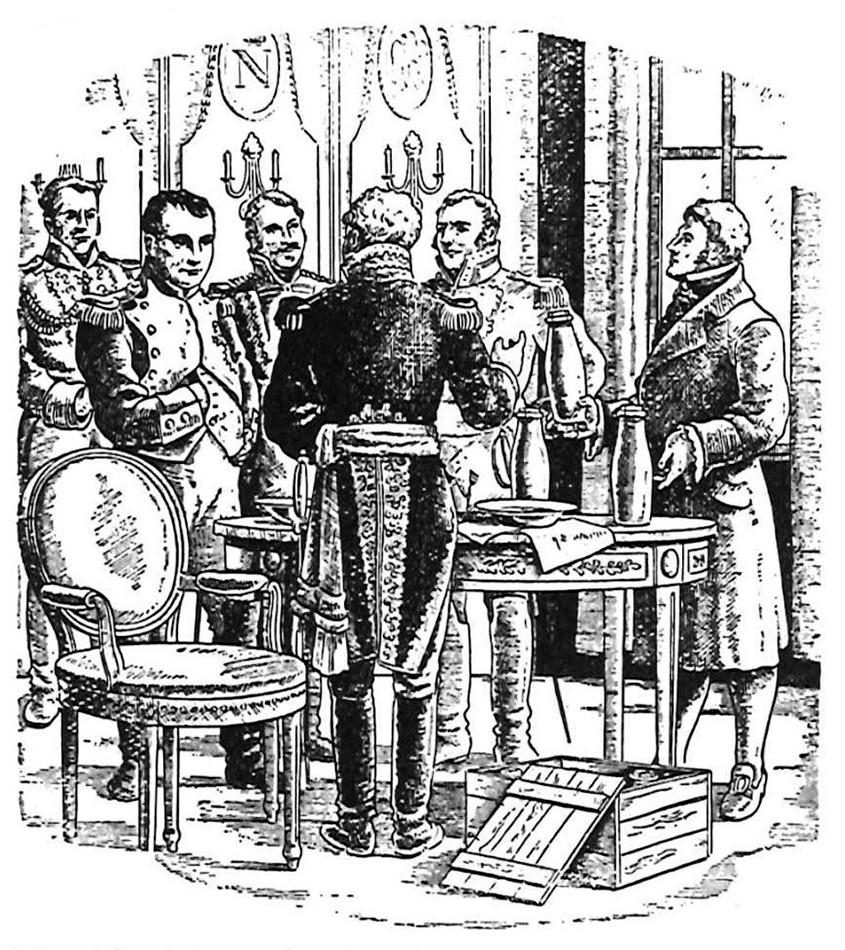
Presentation of canned Apper. Illustration
Examples of dry spikes from different countries and different years
Russia
From June 1, 1941, the Order of the Non-Profit Organization and the Decree of the Council of People's Commissars in the USSR introduced the daily allowance for dry rations per person per day:
- rye crackers - 600 g (black bread);
- millet concentrated porridge - 200 g;
- pea concentrated mashed soup - 75 g;
- half-smoked sausage "Minsk" - 100 g, or dry-smoked / smoked vobla - 150 g, or brynza cheese - 150 g, or dried fish fillet - 100 g, or canned meat - 113 g, or salted herring - 200 g;
- sugar - 35 g;
- tea - 2 g;
- salt - 10 g
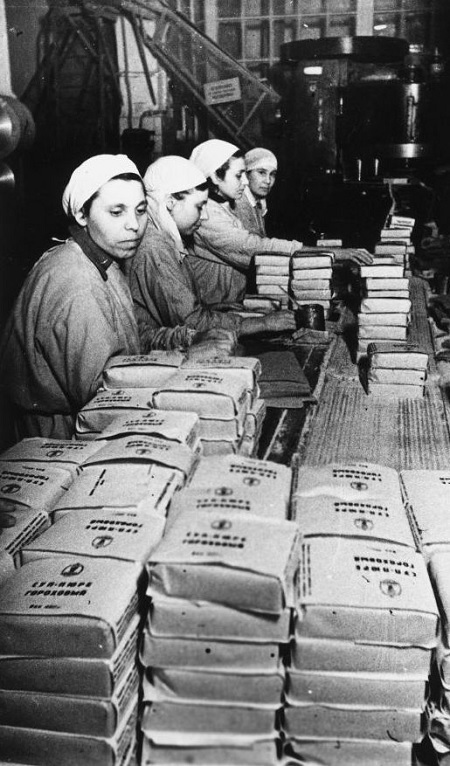
Production of concentrated pea soup puree, plant them. A. Mikoyan. A source
The most common dry ration in the Russian army today is a line of IRP, individual rations. Packaging weighs 1 kg 750 grams and is designed for three meals. And it looks like a New Year's gift.
To set the instruction goes. Pay attention to the elaboration of details for the use of IRP-7. Bread from flour 1 grade are only for breakfast and lunch, and already for dinner it is recommended to eat cake flour. Fish and buckwheat porridge with meat go for breakfast, canned meat - for lunch. And you can dine meat with green peas and carrots.
The energy value of the menu IRP-7 is 3395 kilocalories. Nutrients - 115 grams of protein, 147 grams of fat and 383 grams of carbohydrates.
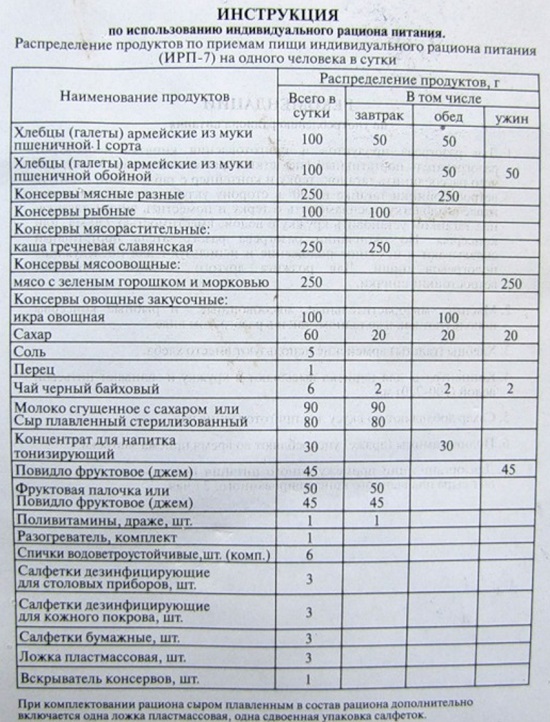
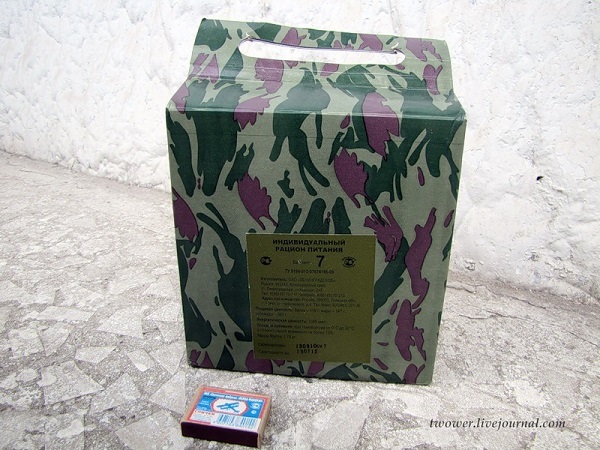


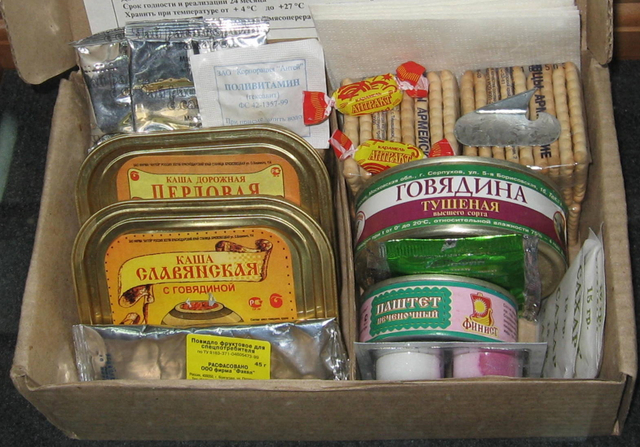
IRP-4. Source: Wikipedia
USA
In 1941, a psychologist from the University of Minnesota was commissioned to develop a complete meal kit for soldiers. Dr. Ansel Keys went to the supermarket and began to choose inexpensive, but optimal in terms of energy products. Cookies, sausages, sweets, chocolate bars have fallen into the set. The value of the first test kit was 3200 calories.
The final diet contained 2830 calories. It included chocolate, tea, canned meats, peanut bars, and even cigarettes.
The first set received paratroopers. The IRP is called K-Rations.
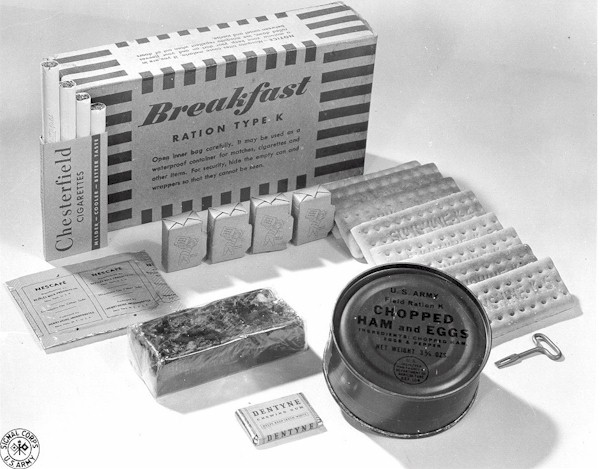
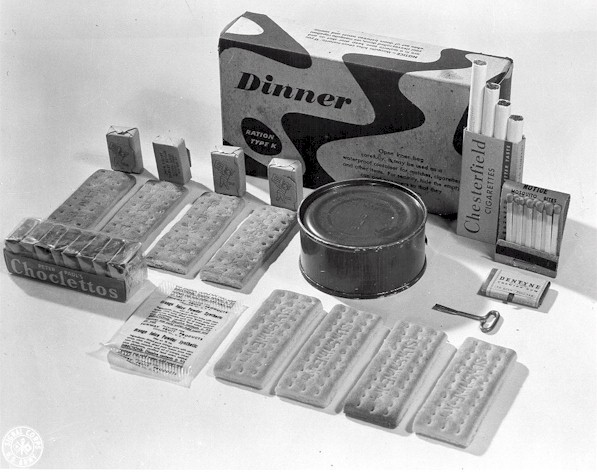
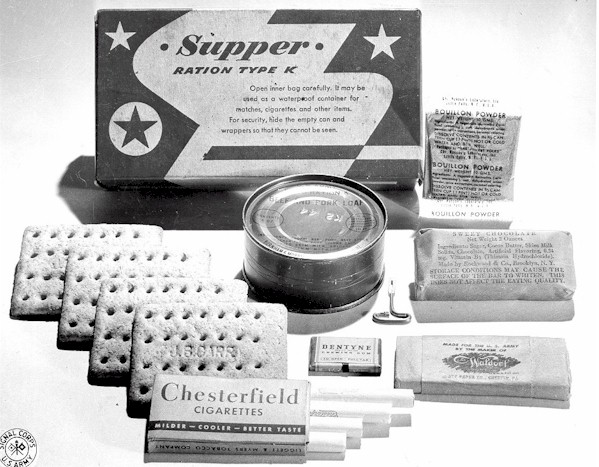
Legend has it that the M & M's candies that appeared in 1941 entered the K-Ration of American soldiers. I could not find confirmation of this. According to available information , Forrest Mars in the late 1930s, while traveling in Spain, saw soldiers eating candy coated with a hard sugar shell and reproduced the recipe in the USA. This is how "milk chocolate that melts in the mouth, but not in the hands." But the candy was definitely sold to the military, as evidenced by posters of the time.

Promotional poster of M & M's sweets that melt in your mouth and not in your hands.
Today, the most popular version of the individual diet in the US is MRE, or Meal, Ready to eat. There are 24 options for this menu. The value of the sets is about 1200 kilocalories, the set weighs up to 750 grams. It is designed ration only for one meal.
The set can include canned meat or fish, hot drinks, juices, sweets - cookies, sweets, biscuits. In addition, there are milkshakes, which would be better called protein drinks, as such a soluble drink contains 17 grams of protein.

Photo: Wikipedia
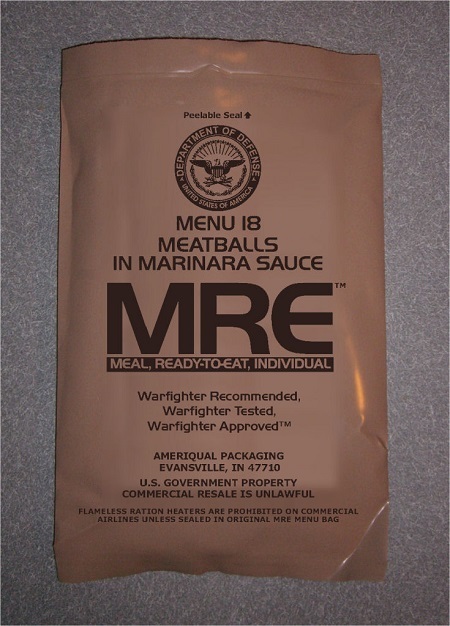
2008 MRE packaging. A source
Another type of dry ration in the US military is First Strike Ration. It is designed to power soldiers performing tasks in isolation from the unit, with increased load and intensive movement. The kit is two times lighter than MRE, but at the same time it is designed for daily food, and not for one meal. Products are packed in such a way that they can be consumed in motion, almost under bullets. The value of the set - 2200-2500 calories.

Canada
Canadian soldiers supply IMP - Individual Meal Pack. The set is balanced in nutrients, and its energy value is 1200-1400 kilocalories.
The development and implementation of a combat ration in Canada takes three years, some dishes are excluded, something is added. Every second year, new products are tested on three groups of sixty people from each army brigade. Today there are twenty-one menu options. Of these, seven - with breakfast, and fourteen - with daytime and evening rations.
The kits include protein shakes, sports drinks, coffee, nut paste, oatmeal, sweets, chocolates, chewing gum. Main dishes - meatloaf with cabernet sauce, pork steak with mustard sauce, sausages with potato cutlets, chili con carne, macaroni with cheese, Swiss steak with Spanish sauce. For dessert - fruit cocktail, pineapple slices, jams. baked apple dessert.
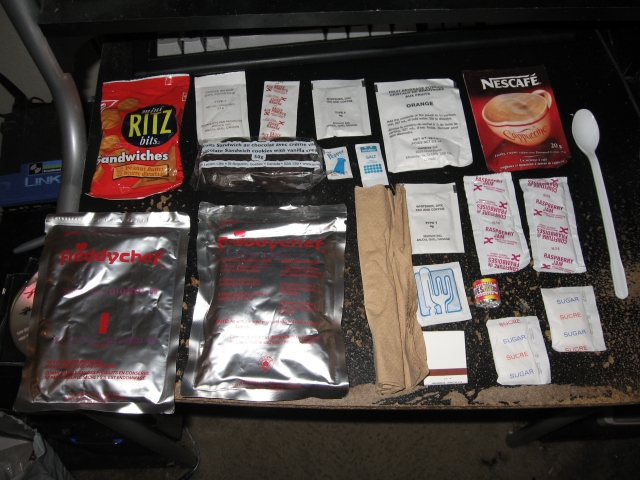
Unpacked IMP. A source
Germany
In combat conditions, the Wehrmacht soldiers received the "Nourishment for war". It was possible in two versions - a daily diet and an inviolable diet. The inviolable ration of Eiserne Portion was spent on the orders of the command when it was not possible to give the soldier normal food. The diet included:
- Hard crackers 250 g
- Canned meat 200 g
- Concentrate soup 150 g
-or canned sausage 150 g. - Natural ground coffee 20 g.
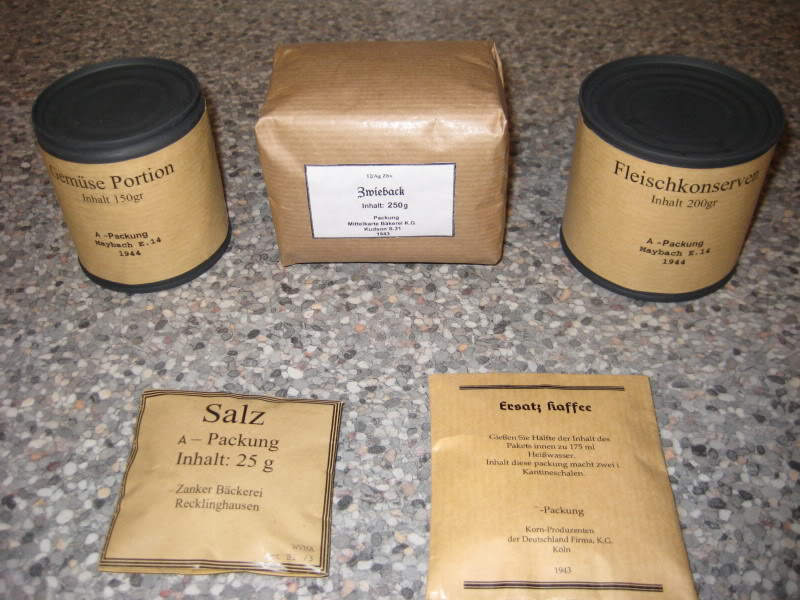
The version of the inviolable ration of the Wehrmacht soldier restored by the enthusiast. A source
The German army today uses the Einmannpackung, an individual ration designed for two meals. It comes in three menu options. The main dishes can be braised lentils with sausages, tagliatelle with bolognese sauce, sausages and goulash with potatoes. For a snack - jams, cheese spreads and sausages. Drinks - tea bags, coffee and powdered juices.

German EPa. A source
France
In France, as in Russia, they try to make the menu of soldiers diverse. There are fourteen variants of the RCIR - “Ration de Combat Individuelle Rechauffable”, the individual ration warmed ration. The energy value of the products in one set is 3200 calories, the set is designed for one person to eat all day.
Interestingly, the menus from the first to the seventh do not contain pork, and from seventh to fourteenth - contain. That is, religion has left an imprint on the food of the French soldiers.
Each kit contains six tablets of dry fuel, matches, and a stand for heating food. In the Russian dry pack includes three pills.
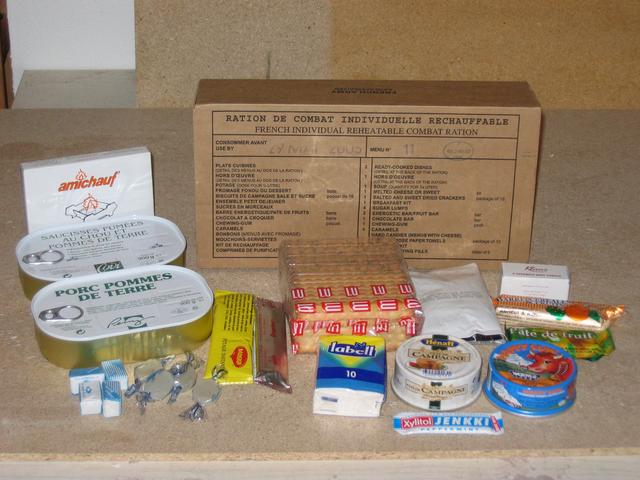
Option RCIR: menu number 11. Source
The menu includes main dishes, soup, melted cheese, salty and sweet crackers, sugar, energy and chocolate bars, chewing gum, caramel, sweets, water purification tablets, paper towels. It was rumored that until the 1990s, French soldiers received a small bottle of wine in such kits. But now this practice is not observed.
The main dishes include tuna in sauce, duck, tuna or pork pate, canned beef. Among the dishes that do not need to be heated are salmon with rice and vegetables, chicken in jelly, beef salad, chili con carne with rabbit.
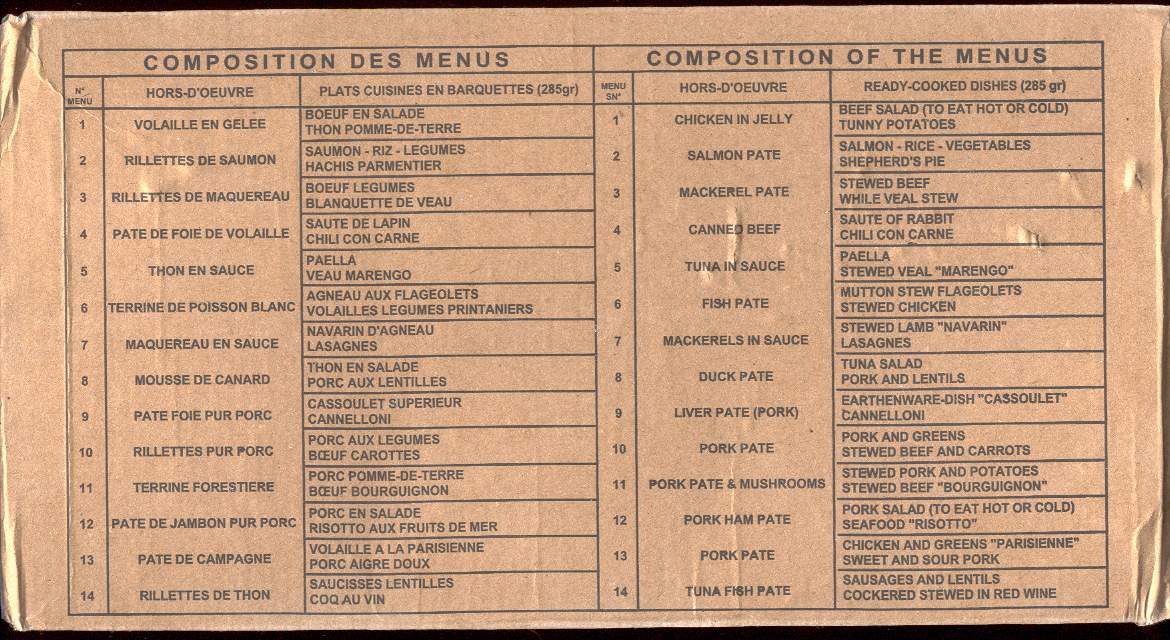
RCIR menu. A source
Israel
The area of Israel - 21 thousand kilometers, the area of the Moscow region - 44 thousand kilometers. On this basis, it can be understood that the presence of a suhpayka is not critical for soldiers on the territory of the country. Each post is located half an hour from the nearest pizzeria, everywhere there is Internet access to make an order. But suhpayki there, they are called Manot Krav.
One set of Manot Krav is designed for four people - the crew of the tank. Early versions assumed that five people would eat - that was how the Sherman team made up. Most of the dishes in the set canned, but if possible, the soldiers get fresh bread and fruit. Territory allows.
The set includes four cans of tuna, soft halvah, chocolate spread, a can of sardines, a can of pickled vegetables, a can of olives or nuts, mustard and ketchup bags, plastic spoons, sweets, garbage bags.
The main component of Manot Krav used to be louf, kosher canned chicken and / or beef ham. She appeared in the 1940s and is the same age as the Israel Defense Forces. But in the 2000s they stopped releasing it , and for some time the soldiers were fed from stocks. It was necessary for something more delicious and fresh. As a result, in 2011, the loof was replaced with minced meat in tomato sauce.
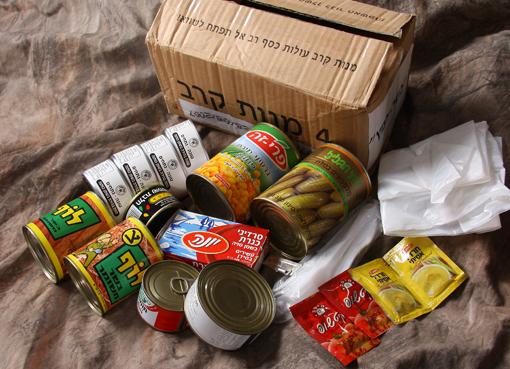
Manot Krav. A source
Conclusion
Above the rations and the duration of their storage scientists are constantly working. In Canada, every three years, ingredients are removed from the diet and new foods are added. Sandwiches that are eaten by American soldiers can be stored for two years by lowering the pH of a bag containing oxygen-absorbing substances.
On the individual army rations imprint culinary preferences of a particular country, as well as religion. If in France the rations are divided by the presence of pork, in Israel the menu is strictly kosher. Another important factor is the distance from the soldiers to the place where there is fresh food. And it's not in the field kitchen: in Israel, you can safely order a pizza instead of using minced meat with tomato sauce from a can.
But sometimes the menu of such sets seems very tasty. Who tried the Russian suhpayki - tell me how they taste?
')
Source: https://habr.com/ru/post/396581/
All Articles